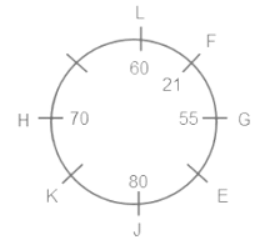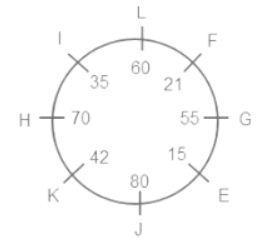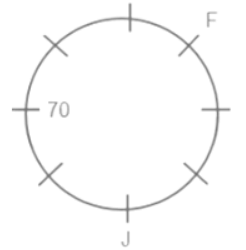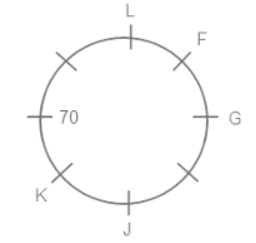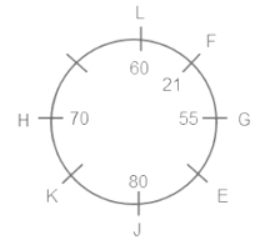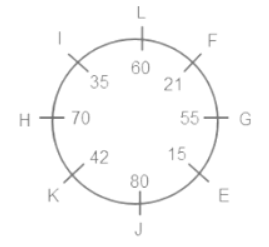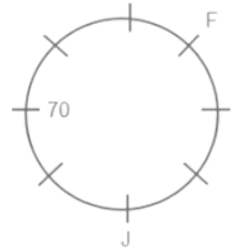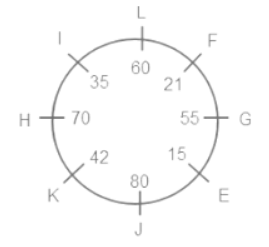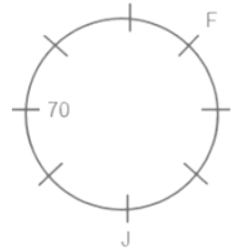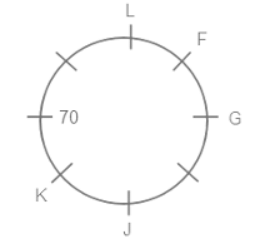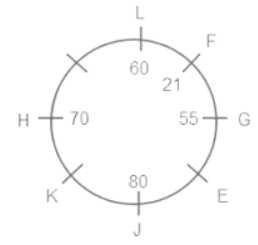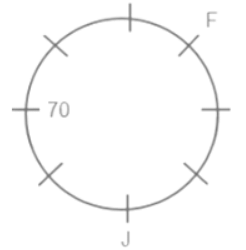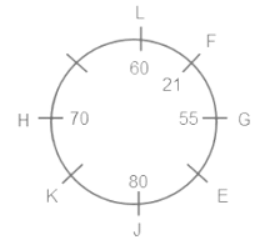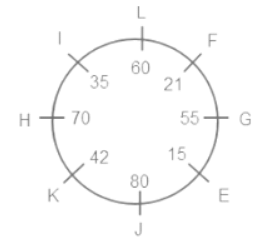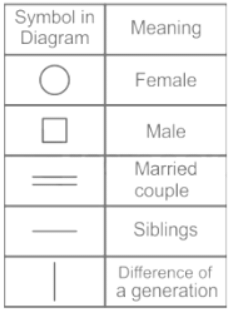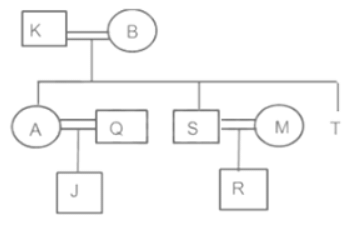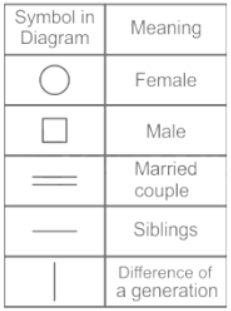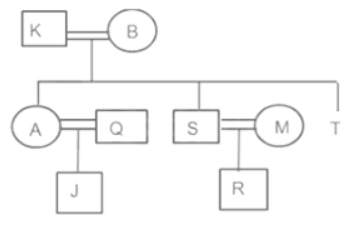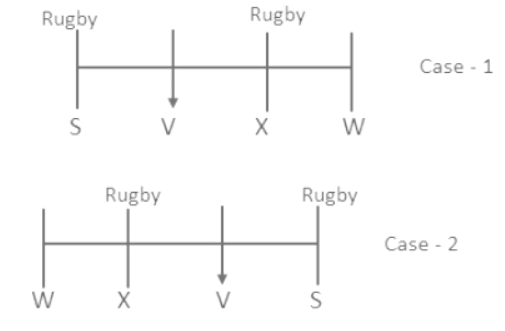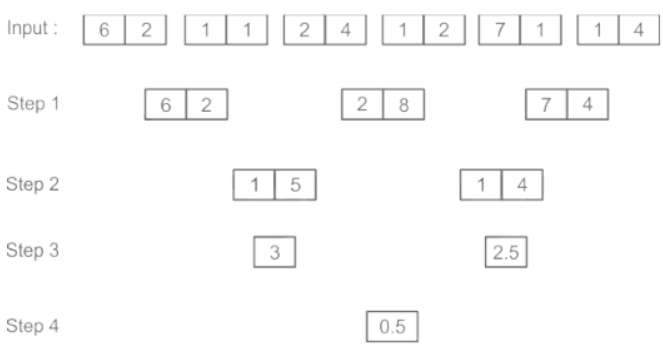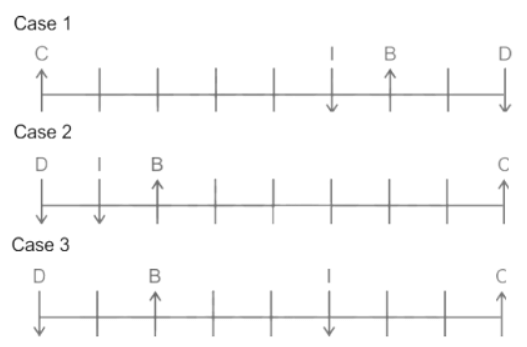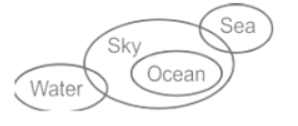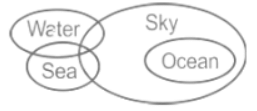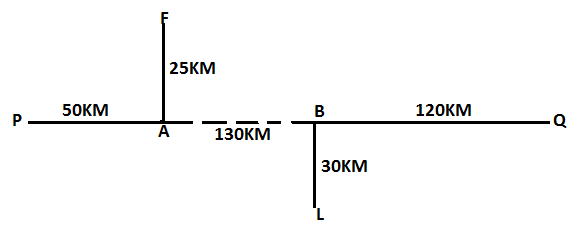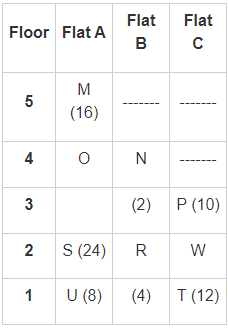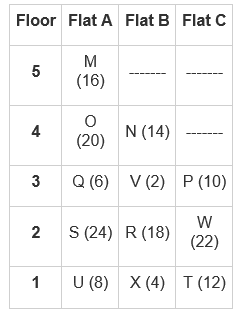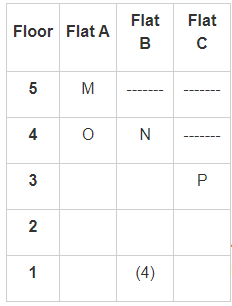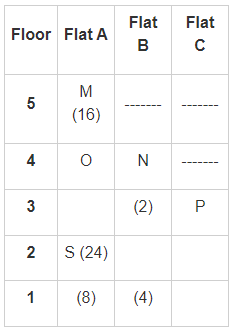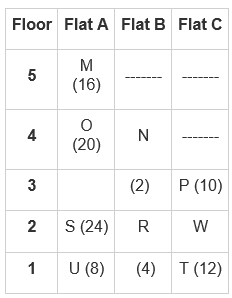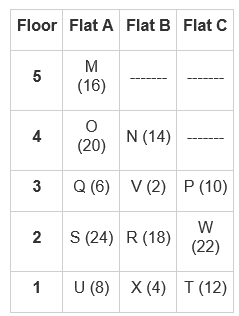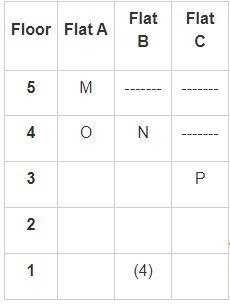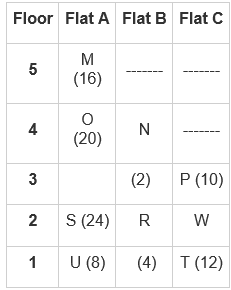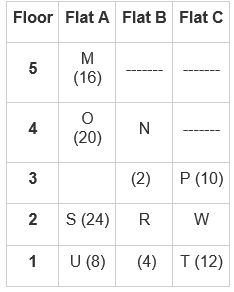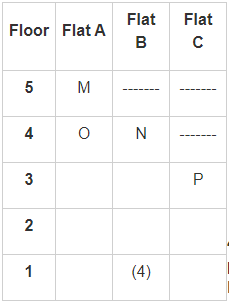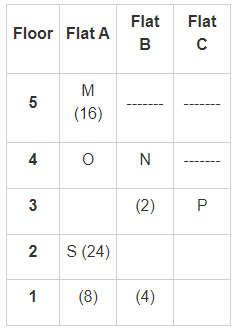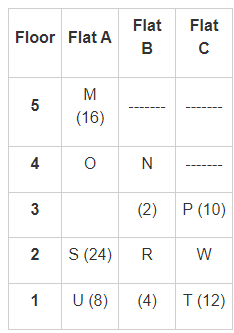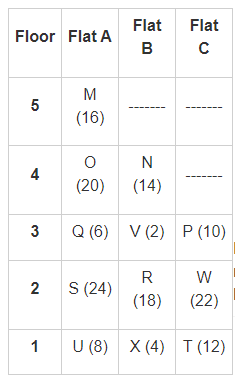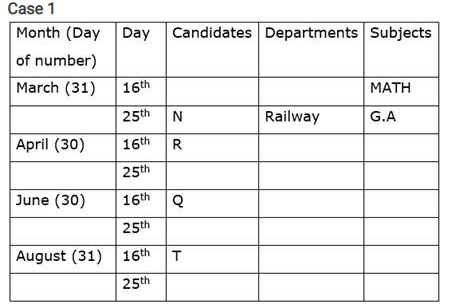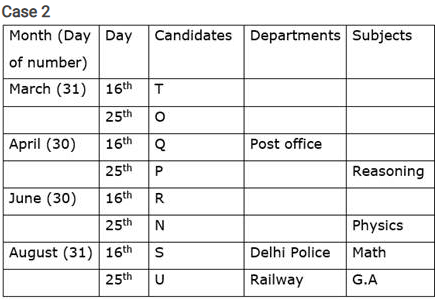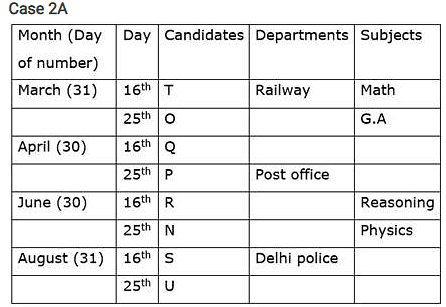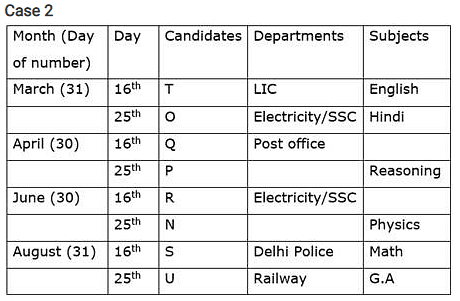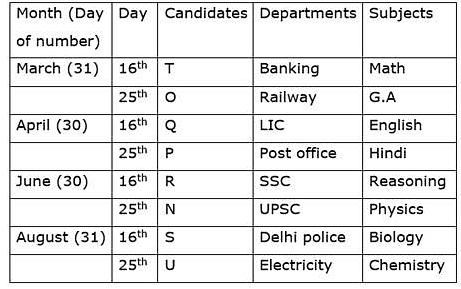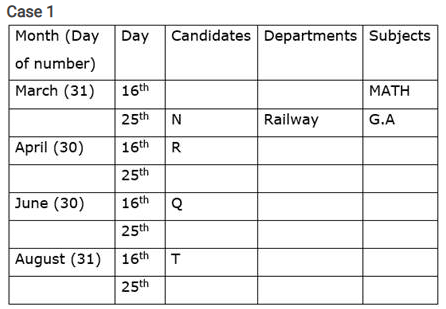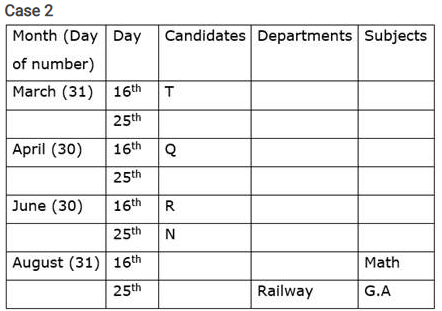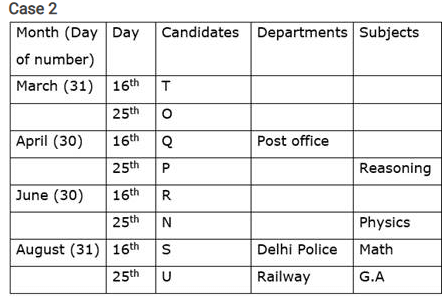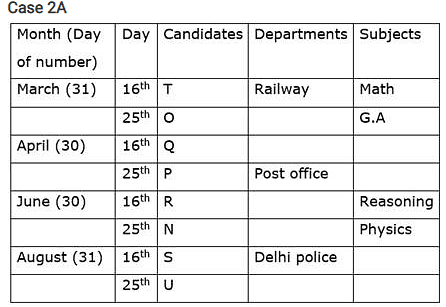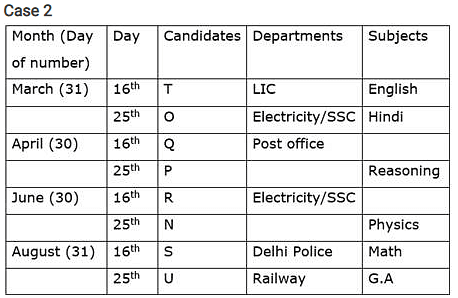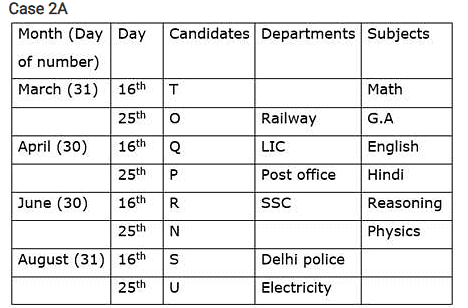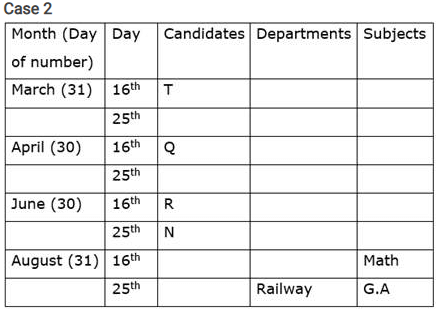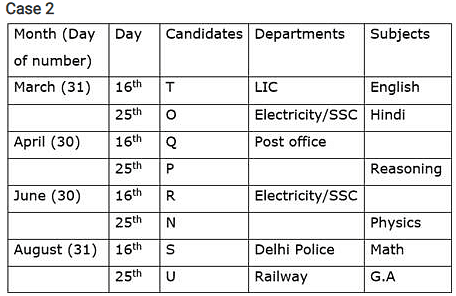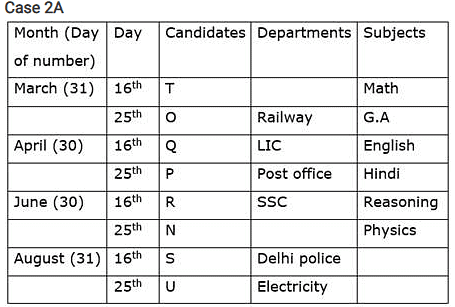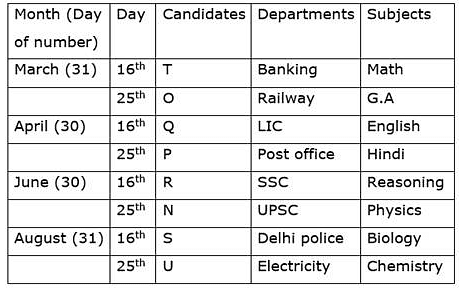IBPS Clerk Mains Mock Test - 10 - Bank Exams MCQ
30 Questions MCQ Test - IBPS Clerk Mains Mock Test - 10
Direction: Study the following information carefully and answer the questions given below.
Eight batsmen, E, F, G, H, I, J, K, and L, are sitting around a circular table facing the center. Each of these batsman has scored the different number of runs in their last innings.
K scored twice as many runs as the person who is sitting opposite him but seven more than I. L has scored 25% less than J and he is sitting third to the left of K. The person sitting third to the right of F has scored 70 runs. F is sitting third to the right of J, who has scored 59 more runs than F. H is sitting third to the left of E and he has scored 10 more runs than the person who is 2nd to his left. G has scored 5 fewer runs than L and he is one of the immediate neighbors of F, also he is sitting second to the left of L. The average score of E and the person sitting on the opposite end is 25.
Which among the following represents the immediate neighbors of the lowest scorer?
Direction: Study the following information carefully and answer the questions given below.
Eight batsmen, E, F, G, H, I, J, K, and L, are sitting around a circular table facing the center. Each of these batsmen has scored the different number of runs in their last innings.
K scored twice as many runs as the person who is sitting opposite him but seven more than I. L has scored 25% less than J and he is sitting third to the left of K. The person sitting third to the right of F has scored 70 runs. F is sitting third to the right of J, who has scored 59 more runs than F. H is sitting third to the left of E and he has scored 10 more runs than the person who is 2nd to his left. G has scored 5 fewer runs than L and he is one of the immediate neighbors of F, also he is sitting second to the left of L. The average score of E and the person sitting on the opposite end is 25.
What is the score of the person who is sitting opposite to E?
Direction: Study the following information carefully and answer the questions given below.
Eight batsmen, E, F, G, H, I, J, K, and L, are sitting around a circular table facing the center. Each of these batsmen has scored the different number of runs in their last innings.
K scored twice as many runs as the person who is sitting opposite him but seven more than I. L has scored 25% less than J and he is sitting third to the left of K. The person sitting third to the right of F has scored 70 runs. F is sitting third to the right of J, who has scored 59 more runs than F. H is sitting third to the left of E and he has scored 10 more runs than the person who is 2nd to his left. G has scored 5 fewer runs than L and he is one of the immediate neighbors of F, also he is sitting second to the left of L. The average score of E and the person sitting on the opposite end is 25.
What is the average score of the highest scorer and the person sitting opposite to him?
Direction: Study the following information carefully and answer the questions given below.
Eight batsmen, E, F, G, H, I, J, K, and L, are sitting around a circular table facing the center. Each of these batsmen has scored the different number of runs in their last innings.
K scored twice as many runs as the person who is sitting opposite him but seven more than I. L has scored 25% less than J and he is sitting third to the left of K. The person sitting third to the right of F has scored 70 runs. F is sitting third to the right of J, who has scored 59 more runs than F. H is sitting third to the left of E and he has scored 10 more runs than the person who is 2nd to his left. G has scored 5 fewer runs than L and he is one of the immediate neighbors of F, also he is sitting second to the left of L. The average score of E and the person sitting on the opposite end is 25.
Who is sitting to the immediate right of E?
Direction: Study the following information carefully and answer the questions given below.
Eight batsmen, E, F, G, H, I, J, K, and L, are sitting around a circular table facing the center. Each of these batsmen has scored the different number of runs in their last innings.
K scored twice as many runs as the person who is sitting opposite him but seven more than I. L has scored 25% less than J and he is sitting third to the left of K. The person sitting third to the right of F has scored 70 runs. F is sitting third to the right of J, who has scored 59 more runs than F. H is sitting third to the left of E and he has scored 10 more runs than the person who is 2nd to his left. G has scored 5 fewer runs than L and he is one of the immediate neighbors of F, also he is sitting second to the left of L. The average score of E and the person sitting on the opposite end is 25.
Who is the highest scorer?
Directions: Study the following information to answer these questions.
A is the sister of S and T. J is the only son of the brother-in-law of S. S is married to M. S is son of K. K and B has three child. A is married to Q. R is son of S.T is unmarried. B is the grandmother of R.
How is B related to M?
Directions: Study the following information to answer these questions.
A is the sister of S and T. J is the only son of the brother-in-law of S. S is married to M. S is son of K. K and B has three children. A is married to Q. R is son of S.T is unmarried. B is the grandmother of R.
How is T related to J?
Directions: Study the following information to answer these questions.
A is the sister of S and T. J is the only son of the brother-in-law of S. S is married to M. S is son of K. K and B has three child. A is married to Q. R is son of S.T is unmarried. B is the grandmother of R.
How R and J are related to each other.
Direction: Study the following information carefully and answer the given questions.
Eight players P, Q, R, S, T, V, W & X are standing in a row in such a way that some of them are facing towards north and some of them facing towards the south. The players belong to three different teams viz. Junior Hockey Team, Junior Football Team & Rugby Team. There are three Rugby players and three Junior Football players in the row.
As per existing policy, age of Junior Hockey players should be from 16 to 21 years, Junior Football players should be from 16 to 18 years and the minimum age of Rugby players should be 18 years. One of the Rugby players is the same age as that of one of the Junior Hockey players. V & Q are the youngest players among the eight players. R is one year younger to T. W is the oldest among them and he is 24 years old. S is three years older than P. P & T don’t belong to the Junior Football team. Also, P is 4 years older to V. V has just attained the minimum age of eligibility for the game he plays. T has also just attained the minimum age to play Rugby. Only three players are facing towards the south. V is facing towards the south and both his immediate neighbors are Rugby players. Both the immediate neighbors of Q are facing south. W is sitting 2nd to the right of T and S is standing 2nd to the right of P. Only V and X are standing between S&W. R is not an immediate neighbor of T and X is not an immediate neighbor of S.
Find the odd one
Direction: Study the following information carefully and answer the given questions.
Eight players P, Q, R, S, T, V, W & X are standing in a row in such a way that some of them are facing towards north and some of them facing towards south. The players belong to three different team viz. Junior Hockey Team, Junior Football Team & Rugby Team. There are three Rugby players and three Junior Football players in the row.
As per existing policy, age of Junior Hockey player should be from 16 to 21 years, Junior Football player should be from 16 to 18 years and the minimum age of Rugby player should be 18 years. One of the Rugby players is the same age as that of one of the Junior Hockey players. V & Q are the youngest players among the eight players. R is one year younger to T. W is the oldest among them and he is 24 years old. S is three years older than P. P&T don’t belong to the Junior Football team. Also, P is 4 years older to V. V has just attained the minimum age of eligibility for the game he plays. T has also just attained the minimum age to play Rugby. Only three players are facing towards the south. V is facing towards the south and both his immediate neighbors are Rugby players. Both the immediate neighbors of Q are facing south. W is sitting 2nd to the right of T and S is standing 2nd to the right of P. Only V and X are standing between S&W. R is not an immediate neighbor of T and X is not an immediate neighbor of S.
Which one is correct for player S?
Direction: Study the following information carefully and answer the given questions.
Eight players P, Q, R, S, T, V, W & X are standing in a row in such a way that some of them are facing towards north and some of them facing towards south. The players belong to three different team viz. Junior Hockey Team, Junior Football Team & Rugby Team. There are three Rugby players and three Junior Football players in the row.
As per existing policy, age of Junior Hockey player should be from 16 to 21 years, Junior Football player should be from 16 to 18 years and the minimum age of Rugby player should be 18 years. One of the Rugby players is the same age as that of one of the Junior Hockey players. V & Q are the youngest players among the eight players. R is one year younger to T. W is the oldest among them and he is 24 years old. S is three years older than P. P&T don’t belong to Junior Football team. Also, P is 4 years older to V. V has just attained the minimum age of eligibility for the game he plays. T has also just attained the minimum age to play Rugby. Only three players are facing towards the south. V is facing towards the south and both the immediate neighbors are Rugby players. Both the immediate neighbors of Q are facing south. W is sitting 2nd to the right of T and S is standing 2nd to the right of P. Only V and X are standing between S&W. R is not an immediate neighbor of T and X is not an immediate neighbor of S.
Who is sitting 3rd to the left of R?
Study the following information carefully and answer the questions given below:
An input - output is given in different steps. Some mathematical operations are done in each step. No mathematical operation is repeated in next step.
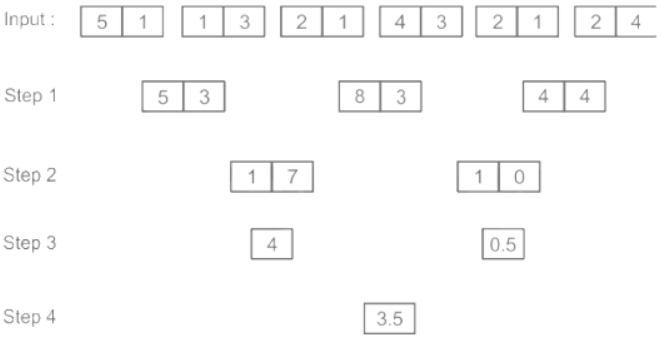
As per the rules followed in the steps given above, find out in each of the following questions the appropriate steps for the given questions:
![]()
Which is the following is the largest number in step I?
Direction: Study the following arrangement and answer questions given:
BCCDALLMMCCCEUMKNNCICKMSSEOFUJJE
Which letter is in middle of row after arranging all the letters in English alphabetical order?
Direction: Study the following arrangement and answer questions given:
BCCDALLMMCCCEUMKNNCICKMSSEOFUJJE
If the all the letter left to right at the positions 10, 5, 13, 27, 6, 5, 4 and 19 are picked up and a meaningful word is formed out of them what would be the second letter of the word? (All the letter are compulsory to use together)
Direction: Study the following arrangement and answer questions given:
BCCDALLMMCCCEUMKNNCICKMSSEOFUJJE
If every letter beginning from position 7, counted from left, is replaced by its successor in the English alphabet and any Z after this position is replaced by A, how many L will be there in the resulting sequence?
Direction: Study the following information carefully and answer the following questions.
Nine persons- A, B, C, D, E, F, G, H, and I are sitting in the linear row. Five of them are facing north and the rest of them is facing south. Also, their age lies between 19 - 47 and none of them has the same age. Not more than two adjacent persons are facing the same direction. B faces north direction. I sit either immediate left or third to the right of B. I and B are facing the opposite direction. Only one person is sitting between B and D, both are facing the opposite direction. The number of persons sitting to the left of D is the same as to the left of C. D sits at the extreme end. Only two persons are sitting between the one whose age is 37 and C. The immediate neighbors of I are facing the same direction. A sits immediate right of H, neither of them is adjacent to C nor B. H and D are facing the opposite direction. A is facing the same direction as I. The age of B is one year more than A. The age of B is twice the age of C. F neither sits adjacent to A nor H. F and the one whose age is 19 are not sitting adjacent to each other. The one whose age is 47 sits third to the left of E. The one whose age is 47 sits to the right of A. The age difference between B and A is the same as between C and D. E’s age is an even number which is two years more than D. H’s age is twice of D. The one whose age is 45 sits immediate right of the one whose age is 38. The age of I is 6 more than the age of E.
What is sum of the age of H and B?
Direction: The question has some statements followed by some conclusions. You have to take the given statements to be true even if they seem to be at variance with commonly known facts. Read all the conclusions and then decide which of the given conclusions logically follows from the given statements disregarding commonly known facts.
Statements:
Some 1 is 2.
Some 2 is 3.
Some 3 is 4.
Some 3 is 5.
Some 5 is 6.
Conclusions:
(1) No 1 is 3
(2) Some 4 is 2
(3) Some 3 is not 6
(4) All 5 is 4
Direction: In the question below are given some statements followed by some conclusions. You have to take the given statements to be true even if they seem to be at variance with commonly known facts. Read all the conclusions and then decide which of the given conclusions logically follows from the given statements disregarding commonly known facts.
Statements:
All cakes are locks
Some locks are keys
Some keys are cars
Conclusions:
I. Some cars are locks
II. Some cars are cakes
III. No car is locks
Direction: The question below consists of a question and three statements numbered I, II and III given. You have to decide whether the data provided in which of the statements are sufficient to answer the question. Choose your answer from the options based on this.
What is the code for ‘business’ in the given code language?
I. “Kites Apple Atm” is written as ‘8t 4p 12t’
II. “After Esu Del” is written as ‘ 17t 16s 8e’
III. “Cause Mremiup Added” is written as ‘2u 3m 3d
Directions: In the question below there are three statements followed by three conclusions I, II and III. You have to take the three given statements to be true even if they seem to be at variance from commonly known facts and then decide which of the given conclusions logically follows from the three statements disregarding commonly known facts.
Statements:
Only a few water are sky
Only sky are ocean
Some sky are sea
Conclusions:
I. All ocean are sky is a possibility
II. Some water are sea is a possibility
III. No Ocean are sea
Direction: The question below consists of a question and three statements numbered I, II and III given. You have to decide whether the data provided in which of the statements are sufficient to answer the question. Choose your answer from the options based on this.
What is the distance between point A and point B?
I. Two bus P and Q, which are 300 km apart in the same road, start moving towards each other on a straight road at a certain point of time.
II. P bus right of M who 100km left of S. the speed of S 40 km/h.
III. The speed of bus P is 50 km/hr and that of bus Q is 60 km/hr.
IV. After first hour bus P which is moving from west to east reached point A and from there takes a left turn, runs for 30 minutes and reaches point F whereas the other bus which was moving from east to west, keeps running on the road till 2 hours to reach point B and then takes a left turn, runs for half an hour and reaches point L.
Direction: Study the following information carefully and answer the following questions.
Twelve Persons M, N, O, P, Q, R, S, T, U, V, W and X live in three flats A, B and C. Flat A is in the west of Flat B, which is in the west of Flat C. Each Person has 1 flat. The dimensions of each floor of the building are the same. Each of them has different numbers of laptops 1 to 24. Each person has an even number of laptops. The bottommost floor is numbered as 1 and the floor above it is 2 and so on. Flats A, B and C have 5, 4 and 3 floors respectively.
Q lives west of the one who has 10 laptops but Q does not have 2 laptops. O lives three floors above the one who has 4 laptops but O does not live on the 5th floor. The one who has 4 laptops lives in N's Flat. N lives North West of P, who lives on the topmost floor in his flat. O neither lives in N's flat nor lives in P's flat. In the same type of Flat only two person live between S and M, who live above S and have 16 laptops. N lives below M but a different type of Flat. In a different flat, M lives two floors above the one who has 2 laptops but P does not have 2 laptops. In the same flat, S lives immediately above the one who has 8 laptops. R does not have 2 laptops but he lives north-east of U. W lives immediately above T in the same type of flat, T has 12 laptops. W and X do not live in flat A. R lives on an even number floor but not in flat C. The one who has 10 laptops lives two floors above T, who does not live on even floors. V does not live below X. The one who has 18 laptops, lives North West of the one who has 12 laptops. The one who has 14 laptops, lives north-east of the one who has 6 laptops. O has more laptops than R but less than W. S has 24 laptops.
What is the sum of the laptops of Persons Q and W?
Direction: Study the following information carefully and answer the following questions.
Twelve Persons M, N, O, P, Q, R, S, T, U, V, W and X are live in three flats A, B and C. Flat A is in the west of Flat B, which is in the west of Flat C. Each Person has 1 flat. The dimensions of each floor of the building are the same. Each of them has different numbers of laptops 1 to 24. Each person has laptop in even number of laptops. The bottommost floor is numbered as 1 and the floor above it is 2 and so on. Flats A, B and C have 5, 4 and 3 floors respectively.
Q lives west of the one who has 10 laptops but Q does not have 2 laptops. O lives three floors above the one who has 4 laptops but O does not live on the 5th floor. The one who has 4 laptops lives in N's Flat. N lives North West of P, who lives on the topmost floor in his flat. O neither lives in N's flat nor lives in P's flat. In the same type of Flat only two person live between S and M, who lives above S and have 16 laptops. N lives below M but a different type of Flat. In different flat, M lives two floors above the one who has 2 laptops but P does not have 2 laptops. In the same flat, S lives immediately above the one who has 8 laptops. R does not have 2 laptops but he lives north-east of U. W lives immediately above T in the same type of flat, T has 12 laptops. W and X do not live in flat A. R lives on an even number floor but not in flat C. The one who has 10 laptops lives two floors above T, who does not live on the even floor. V does not live below X. The one who has 18 laptops, lives North West of the one who has 12 laptops. The one who has 14 laptops, lives north-east of the one who has 6 laptops. O has more laptops than R but less than W. S has 24 laptops.
Who among the following person lives just below the one who has 2 laptops in the same type of flat?
Direction: Study the following information carefully and answer the following questions.
Twelve Persons M, N, O, P, Q, R, S, T, U, V, W and X live in three flats A, B and C. Flat A is in the west of Flat B, which is in the west of Flat C. Each Person has 1 flat. The dimensions of each floor of the building are the same. Each of them has different numbers of laptops 1 to 24. Each person has an even number. The bottommost floor is numbered as 1 and the floor above it is 2 and so on. Flats A, B and C have 5, 4 and 3 floors respectively.
Q lives west of the one who has 10 laptops but Q does not have 2 laptops. O lives three floors above the one who has 4 laptops but O does not live on the 5th floor. The one who has 4 laptops lives in N's Flat. N lives North West of P, who lives on the topmost floor in his flat. O neither lives in N's flat nor lives in P's flat. In the same type of Flat only two person live between S and M, who live above S and has 16 laptops. N lives below M but a different type of Flat. In a different flat, M lives two floors above the one who has 2 laptops but P does not have 2 laptops. In the same flat, S lives immediately above the one who has 8 laptops. R does not have 2 laptops but he lives north-east of U. W lives immediately above T in the same type of flat, T has 12 laptops. W and X do not live in flat A. R lives on an even number floor but not in flat C. The one who has 10 laptops lives two floors above T, who does not live on the even floor. V does not live below X. The one who has 18 laptops, lives North West of the one who has 12 laptops. The one who has 14 laptops, lives north-east of the one who has 6 laptops. O has more laptops than R but less than W. S has 24 laptops.
Who among the following lives to the south east of R?
Direction: Study the following information carefully and answer the following questions.
Twelve Persons M, N, O, P, Q, R, S, T, U, V, W and X live in three flats A, B and C. Flat A is in the west of Flat B, which is in the west of Flat C. Each Person has 1 flat. The dimensions of each floor of the building are the same. Each of them has different numbers of laptops 1 to 24. Each person has laptop in even number of laptops. The bottommost floor is numbered as 1 and the floor above it is 2 and so on. Flats A, B and C have 5, 4 and 3 floors respectively.
Q lives west of the one who has 10 laptops but Q does not have 2 laptops. O lives three floors above the one who has 4 laptops but O does not live on the 5th floor. The one who has 4 laptops lives in N's Flat. N lives North West of P, who lives on the topmost floor in his flat. O neither lives in N's flat nor lives in P's flat. In same type of Flat only two person live between S and M, who live above S and has 16 laptops. N lives below M but a different type of Flat. In a different flat, M lives two floors above the one who has 2 laptops but P does not have 2 laptops. In the same flat, S lives immediately above the one who has 8 laptops. R does not have 2 laptops but he lives north-east of U. W lives immediately above T in the same type of flat, T has 12 laptops. W and X do not live in flat A. R lives on an even number floor but not in flat C. The one who has 10 laptops lives two floors above T, who does not live on the even floor. V does not live below X. The one who has 18 laptops, lives North West of the one who has 12 laptops. The one who has 14 laptops, lives north-east of the one who has 6 laptops. O has more laptops than R but less than W. S has 24 laptops.
Four from the following five are related in a certain way and hence form a group. Find the one which doesn’t belong to that group?
Direction: Study the following information carefully and answer the following questions.
Twelve Persons M, N, O, P, Q, R, S, T, U, V, W and X live in three flats A, B and C. Flat A is in the west of Flat B, which is in the west of Flat C. Each Person has 1 flat. The dimensions of each floor of the building are the same. Each of them has different numbers of laptops 1 to 24. Each person has an even number. The bottommost floor is numbered as 1 and the floor above it is 2 and so on. Flats A, B and C have 5, 4 and 3 floors respectively.
Q lives west of the one who has 10 laptops but Q does not have 2 laptops. O lives three floors above the one who has 4 laptops but O does not live on the 5th floor. The one who has 4 laptops lives in N's Flat. N lives North West of P, who lives on the topmost floor in his flat. O neither lives in N's flat nor lives in P's flat. In the same type of Flat only two people live between S and M, who live above S and have 16 laptops. N lives below M but a different type of Flat. In a different flat, M lives two floors above the one who has 2 laptops but P does not have 2 laptops. In the same flat, S lives immediately above the one who has 8 laptops. R does not have 2 laptops but he lives north-east of U. W lives immediately above T in the same type of flat, T has 12 laptops. W and X do not live in flat A. R lives on an even number floor but not in flat C. The one who has 10 laptops lives two floors above T, who does not live on the even floor. V does not live below X. The one who has 18 laptops, lives North West of the one who has 12 laptops. The one who has 14 laptops, lives north-east of the one who has 6 laptops. O has more laptops than R but less than W. S has 24 laptops.
How many persons live towards the north of the person who has 8 laptops?
Direction: Read the given information carefully and answer the questions given below.
Eight candidates i.e. N, O, P, Q, R, S, T, and U enrolled in a coaching in the different month of the same year viz. March, April, June, and August. Each month, Each of them prepares for different sectors going coaching for the admission either on 16th or 25th of the month. Not more than two candidates have been enrolled in the same month. Each candidate likes a different subject.
Two candidates enrolled between P and the one who prepared for Delhi police department. The one who prepares for the Railway department likes GA subject enrolled on the odd date of the month which has 31 days. R enrolled on 16th of the month which has only 30 days. Only three candidates have to enroll between R and T. Two candidates enrolled between O and the one who likes the Reasoning subject who enrolled on the date just after the one who prepares for the post office department. N and T have to enroll neither on the same day nor in the same month. The one who likes Physics subject enrolled on the date just before the one who prepares for Delhi police department. N does not enroll in the month of April. Only two candidates enrolled between N and Q. S and Q enroll dates are the same but in different months. The one who prepares for the LIC department also likes English subjects who do not enroll on odd number dates.
O has enrolled on one of the days before S enrolled. Only one person is enrolling between O and P. The one who likes GA subject enrolled on the date just after the one who likes Math subject who does not prepare for Delhi police department. Less than four candidates have to enroll between P and U. The one who likes Hindi subjects enrolled on the date just after the one who prepared for the LIC department. Two candidates enrolled between the one who prepares for the SSC department and the Electricity department who just enrolled just after the one who likes Biology and who does not preparation for the post office department. One candidate enrolled between the one who prepares for UPSC and the one who likes Chemistry. The one candidate in this group who prepares for the banking department.
How many candidates enrolled between the one who likes G.A and the one who likes Biology?
Direction: Read the given information carefully and answer the questions given below.
Eight candidates i.e. N, O, P, Q, R, S, T, and U enrolled in a coaching in the different month of the same year viz. March, April, June, and August. Each month, Each of them prepares for different sectors going coaching for the admission either on 16th or 25th of the month. Not more than two candidates have been enrolled in the same month. Each candidate likes a different subject.
Two candidates enrolled between P and the one who prepared for Delhi police department. The one who prepares for the Railway department likes GA subjects enrolled on the odd date of the month which has 31 days. R enrolled on 16th of the month which has only 30 days. Only three candidates have to enroll between R and T. Two candidates enrolled between O and the one who likes the Reasoning subject who enrolled on the date just after the one who prepares for the post office department. N and T have to enroll neither on the same day nor in the same month. The one who likes Physics subject enrolled on the date just before the one who prepares for Delhi police department. N does not enroll in the month of April. Only two candidates enrolled between N and Q. S and Q enroll dates are the same but in different months. The one who prepares for the LIC department also likes English subjects who do not enroll on odd number dates.
O has enrolled on one of the days before S enrolled. Only one person is enrolling between O and P. The one who likes GA subject enrolled on the date just after the one who likes Math subject who does not prepare for Delhi police department. Less than four candidates have to enroll between P and U. The one who likes Hindi subjects enrolled on the date just after the one who prepared for the LIC department. Two candidates enrolled between the one who prepares for the SSC department and the Electricity department who just enrolled just after the one who likes Biology, who does not prepare for the post office department. One candidate enrolled between the one who prepares for UPSC and the one who likes Chemistry. The one candidate in this group who prepares for the banking department.
N prepares for which of the following Department?
Direction: Read the given information carefully and answer the questions given below.
Eight candidates i.e. N, O, P, Q, R, S, T, and U enrolled in a coaching in the different month of the same year viz. March, April, June, and August. Each month, Each of them prepares for different sectors going coaching for the admission either on 16th or 25th of the month. Not more than two candidates have been enrolled in the same month. Each candidate likes a different subject.
Two candidates enrolled between P and the one who prepared for Delhi police department. The one who prepares for the Railway department likes GA subjects enrolled on the odd date of the month which has 31 days. R enrolled on 16th of the month which has only 30 days. Only three candidates have to enroll between R and T. Two candidates enrolled between O and the one who likes the Reasoning subject who enrolled on the date just after the one who prepares for the post office department. N and T have to enroll neither on the same day nor in the same month. The one who likes Physics subject enrolled on the date just before the one who prepares for Delhi police department. N does not enroll in the month of April. Only two candidates enrolled between N and Q. S and Q enroll dates are the same but in different months. The one who prepares for the LIC department also likes English subjects who do not enroll on odd number dates.
O has enrolled on one of the days before S enrolled. Only one person is enrolling between O and P. The one who likes GA subject enrolled on the date just after the one who likes Math subject who does not prepare for Delhi police department. Less than four candidates have to enroll between P and U. The one who likes Hindi subjects enrolled on the date just after the one who prepared for the LIC department. Two candidates enrolled between the one who prepares for the SSC department and the Electricity department who just enrolled just after the one who likes Biology and who does not prepare for the post office department. One candidate enrolled between the one who prepares for UPSC and the one who likes Chemistry. The one candidate in this group who prepares for the banking department.
Which of the following candidates prepare for the banking department?
Directions: In the following question assuming the given statements to be True, find which of the conclusion among given conclusions is / are definitely true and then give your answers accordingly.
Statements: P < Q < R; R > S < T; T = U > V > W; W = X < Y < Z
Conclusions:
I. P < T
II. R > Z
III. U < Z




